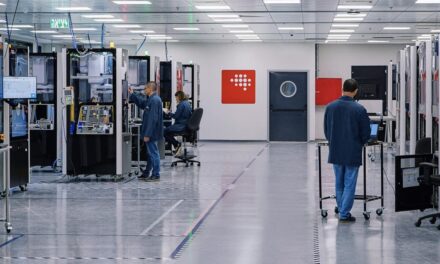Building Electronic Assemblies for the Marine Industry
By Phil Simmonds, CEO of EC Electronics

Phil Simmonds
The widespread growth of electronic content in the marine industry is forecast to continue across many different areas — from naval defence to trade and fishing.
And with this growth comes increased demand within the marine electronics market, as rapid digitisation drives the necessity for more electrical components to carry out a range of functions on marine vessels and other maritime equipment.
For example, rising levels of seafood consumption go hand in hand with the heightened demand for advanced SONAR systems. Plus, as global trade increases, so too does the use of advanced electronic navigation and radar systems, as well as satellite uplinks.
From cable assemblies for boat windscreen wipers to complex navigation systems, electronics products are found in a wide range of marine mechanical and electrical systems. They are crucial to maintaining functionality and safety, as well as the management of navigation technology. So, what are some of the key considerations when manufacturing electronics for the marine sector to ensure the highest safety and performance standards for all the electrical components involved?
Improving safety and functionality
Whether you are on board a working or recreational vessel, safety and seamless use are paramount at sea. Technology performs daily functions that improve functionality, comprising essential devices that reliably ensure maritime safety and connectivity.
For example, autopilot is a highly advanced system used to improve navigation on maritime vessels, but faults in the equipment can result in dangerous accidents at sea. For marine autopilot systems to fulfil their function and keep a ship on its predetermined course, they must interpret and coordinate data from multiple devices on board a vessel with control and propulsion systems.
Simple multi-function displays (MFDs) allow captains and crew to view and monitor different systems in one place — critical aboard large vessels with numerous electronics systems. MFDs act as the centralised brain of a boat, incorporating systems into one interface that may feature either a touch screen or keypad control.
And if the worst should happen, staying connected to emergency services and communicating with other mariners is a paramount safety consideration. Very high frequency (VHF) radio combines a transmitter and receiver to make a critical piece of safety gear specified for marine use. This type of radio provides the most reliable form of communication between a vessel and the authorities in an emergency — or with harbours, locks, bridges and marinas.
Facilitating seamless navigation
At sea, conditions are constantly changing and can quickly become volatile if the appropriate technology is not present to navigate a safe and efficient course. Therefore, awareness of the surrounding waters, land and weather fronts is an imperative factor for mariners.
Course-plotting relies on the consistent function of electrical navigation systems. Marine GPS is a form of space-based radio navigation system — similar to the GPS we use on our smartphones — that broadcasts navigation pulses to users to determine their location at sea. This technology performs a crucial function on board; without it, vessels may veer off-course into dangerous environments.
Marine radars broadcast pulses which are reflected by other boats, land or even by weather anomalies. These radars provide accurate information for viewing on display screens, detailing the placement of other objects in the body of water around a vessel to alert those on board to their proximity to hazards.
Electronics navigation systems are also essential to inform mariners of their immediate surroundings and must work perfectly at all times. For example, deep-sea fishers use SONAR (or fishfinder) equipment to identify the optimal location for their catch. These acoustic devices detect reflected pulses of sound to locate underwater objects, such as fish. Without these devices, fishers would be operating blind and waste precious time and financial resources.
Concerns for marine electronics manufacturers

PCB assemblies fitted in to plastic cases and the next phase will be to add the potting
The ever-increasing electronic content and continuous technological advancements in the marine sector make it one of the most challenging markets to manufacture for. Plus, as the sub-assemblies supplied for use in marine mechanical and electrical systems are critical to the seamless performance of navigation technology, safety and security, guaranteeing high-quality, zero-defect production is crucial.
Many maritime electrical devices rely on components and sub-assemblies like printed circuit boards (PCBs) and cable assemblies. Given the nature of their usage and exposure to the elements, marine products must be built robustly to withstand wind, hydrostatic pressures and ultraviolet light. However, one of the most significant challenges facing manufacturers is salt spray. Saltwater is far more corrosive than freshwater, so this is a crucial consideration when manufacturing marine electronics.
Integral PCBs can be coated to protect against corrosion using overmoulding — an encapsulation process whereby the assembly is placed in a specially manufactured aluminium mould tool and surrounded with a liquid compound to create a protective barrier. Overmoulding PCBs is a unique, specialist skill, but it is essential for manufacturers wanting to protect electronics in the marine market.
Ingress protection is also a vital consideration in this field to ensure product performance and reliability. Products that will be subject to extensive water spray or powerful high-pressure water and steam jets will require the highest ingress protection ratings of IP68 and IP69K to ensure they remain fit for use.

Another potted assembly
As part of the encapsulation process, manufacturers can utilise multiple materials and techniques to create additional layers that protect against corrosion and ingress. For instance, softer materials can be used for the inside layer to provide better protection and sealing properties, whilst harder materials can offer better durability for the outer layer.
Damage from ultraviolet light is another issue for marine manufacturers to tackle; the materials used for overmoulding must be able to withstand long-term, consistent exposure to ultraviolet light without fading. Equally, manufacturers must take wind speeds into account when creating products. For example, cable assemblies running along a mast need to be small and lightweight to avoid tilting the boat — particularly in high wind conditions.
In harsh marine environments where devices and machinery are relied on for safety and productivity, these considerations are imperative for marine electronics manufacturers to ensure the safe delivery and operation of equipment at sea.
When providing modules and sub-assemblies for the marine sector, EC Electronics only manufactures electronics to the highest quality levels — including IPC-A-610 standards for PCB assemblies and IPC/WHMA-A-620 for cable assemblies.












